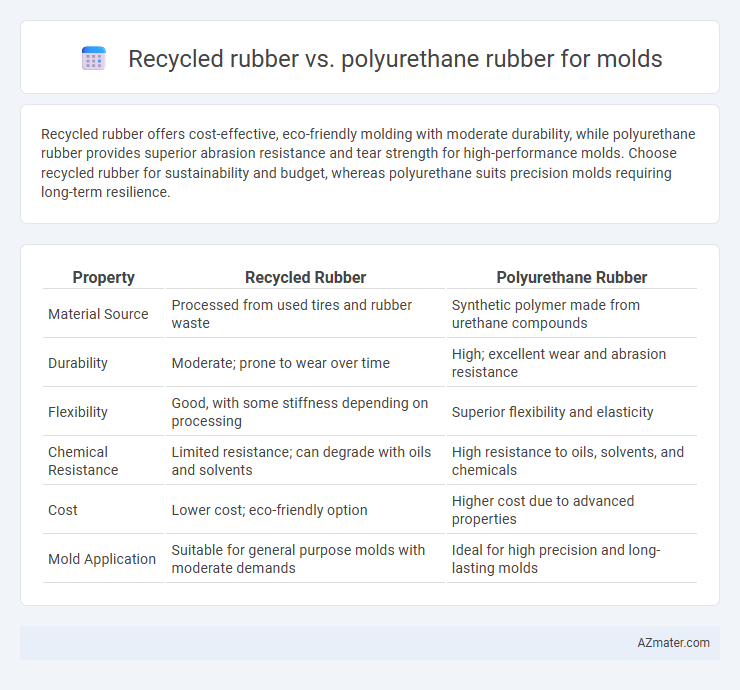Recycled rubber offers cost-effective, eco-friendly molding with moderate durability, while polyurethane rubber provides superior abrasion resistance and tear strength for high-performance molds. Choose recycled rubber for sustainability and budget, whereas polyurethane suits precision molds requiring long-term resilience.
Table of Comparison
| Property | Recycled Rubber | Polyurethane Rubber |
|---|---|---|
| Material Source | Processed from used tires and rubber waste | Synthetic polymer made from urethane compounds |
| Durability | Moderate; prone to wear over time | High; excellent wear and abrasion resistance |
| Flexibility | Good, with some stiffness depending on processing | Superior flexibility and elasticity |
| Chemical Resistance | Limited resistance; can degrade with oils and solvents | High resistance to oils, solvents, and chemicals |
| Cost | Lower cost; eco-friendly option | Higher cost due to advanced properties |
| Mold Application | Suitable for general purpose molds with moderate demands | Ideal for high precision and long-lasting molds |
Introduction to Mold-Making Materials
Recycled rubber offers an eco-friendly and cost-effective option for mold-making materials, characterized by its durability and flexibility suitable for various casting applications. Polyurethane rubber provides superior chemical resistance, high tear strength, and precise detail reproduction, making it ideal for intricate molds requiring longevity and performance. Selecting between recycled and polyurethane rubber hinges on balancing environmental impact, budget constraints, and specific mold-use requirements.
What is Recycled Rubber?
Recycled rubber is derived from repurposed scrap tires and industrial rubber waste, offering an eco-friendly option for mold making by reducing landfill impact and conserving natural resources. It provides good elasticity and durability but may have inconsistent quality compared to polyurethane rubber, which is a synthetic polymer known for superior resistance to abrasion, chemicals, and aging. Choosing recycled rubber molds supports sustainability and cost-effectiveness, especially in applications where environmental concerns are prioritized.
What is Polyurethane Rubber?
Polyurethane rubber is a versatile elastomer known for its exceptional durability, abrasion resistance, and flexibility, making it ideal for mold applications requiring precise detail and longevity. Unlike recycled rubber, polyurethane offers superior mechanical properties such as higher tensile strength and better resistance to oils and chemicals, ensuring longer mold life and consistent performance. Its ability to maintain structural integrity under stress makes polyurethane rubber a preferred choice for high-precision and industrial molding processes.
Environmental Impact: Recycled vs Polyurethane Rubber
Recycled rubber significantly reduces landfill waste and conserves natural resources by repurposing used tires and rubber products, leading to a lower carbon footprint compared to polyurethane rubber. Polyurethane rubber, while durable and flexible, is derived from petrochemical sources and generates more greenhouse gas emissions during production and disposal. Choosing recycled rubber for molds supports circular economy principles and minimizes environmental pollution associated with synthetic rubber manufacturing.
Durability and Longevity Comparison
Recycled rubber molds offer moderate durability with resistance to abrasion and moderate chemical exposure, making them cost-effective for short-term or low-impact applications. Polyurethane rubber molds exhibit superior longevity due to enhanced tensile strength, elasticity, and resistance to heat, oils, and solvents, which extend their functional lifespan significantly in demanding industrial environments. The choice between recycled and polyurethane rubber molds hinges on the required durability, with polyurethane molds providing better performance under high-stress conditions.
Flexibility and Mold Detail Reproduction
Recycled rubber offers moderate flexibility and is suitable for basic mold applications, but it often lacks the fine detail reproduction required for intricate designs. Polyurethane rubber provides superior flexibility, allowing molds to stretch and release easily without deformation while capturing high-resolution details with exceptional precision. The enhanced elasticity and fine reproduction capabilities of polyurethane rubber make it the preferred choice for molds demanding both durability and intricate detail fidelity.
Cost Analysis: Recycled vs Polyurethane Rubber
Recycled rubber molds offer a significantly lower upfront cost compared to polyurethane rubber molds, making them a budget-friendly option for large-scale or short-term projects. Polyurethane rubber molds, while more expensive initially, provide superior durability and detail retention, reducing long-term replacement expenses and improving cost efficiency in high-precision applications. Considering the total cost of ownership, recycled rubber is cost-effective for rapid prototyping, whereas polyurethane delivers better value for extended production runs due to its longevity.
Safety and Health Considerations
Recycled rubber molds offer significant environmental benefits but may contain residual chemicals or contaminants that pose health risks during handling or processing, necessitating proper ventilation and protective equipment. Polyurethane rubber, often preferred for its consistent composition and lower toxicity, minimizes exposure to hazardous substances and is generally safer for workers in mold-making environments. Both materials require adherence to safety guidelines to prevent respiratory irritation and skin sensitization, with polyurethane providing more predictable health safety profiles in controlled manufacturing settings.
Application Suitability for Recycled and Polyurethane Rubber
Recycled rubber excels in applications requiring cost-effective, environmentally friendly materials with moderate durability, such as playground surfaces, mats, and non-critical sealing components. Polyurethane rubber offers superior abrasion resistance, elasticity, and chemical stability, making it ideal for precision molds in automotive parts, industrial machinery, and high-performance seals. Choosing between recycled and polyurethane rubber depends on the specific demands of the mold application, balancing durability, flexibility, and budget constraints.
Final Verdict: Which Rubber is Best for Your Mold?
Recycled rubber offers cost-effectiveness and eco-friendliness with moderate durability, making it suitable for less demanding molds or prototypes. Polyurethane rubber provides superior abrasion resistance, flexibility, and longer lifespan, ideal for high-precision, long-run molds requiring detailed finishes. For production molds demanding durability and repeatability, polyurethane rubber is the best choice, while recycled rubber suits budget-conscious or short-term applications.

Infographic: Recycled rubber vs Polyurethane rubber for Mold
 azmater.com
azmater.com